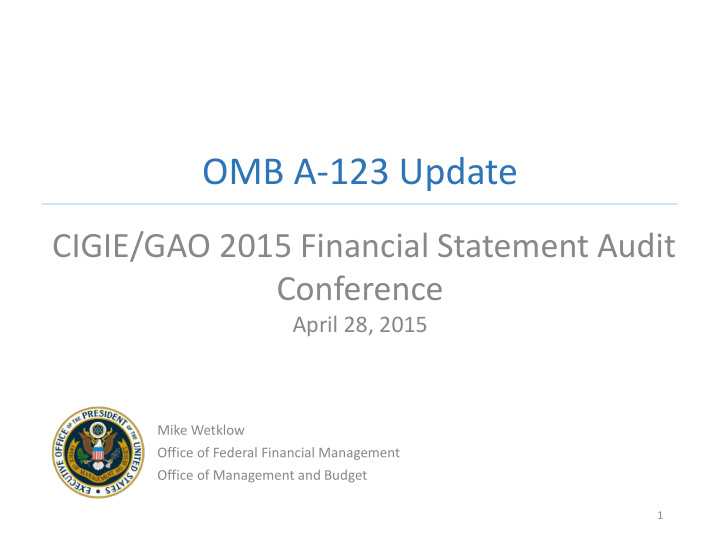



OMB A-123 Update CIGIE/GAO 2015 Financial Statement Audit Conference April 28, 2015 Mike Wetklow Office of Federal Financial Management Office of Management and Budget 1
A-123 History • 1981 – OMB First Issued Circular No. A-123, Internal Control Systems • 1982 – OMB Issued Internal Control Guidelines and the Federal Managers Financial Integrity Act was enacted • 1983 – OMB Issued an Updated Circular No. A-123, Internal Control Systems • 1986 – OMB Updated A-123 to Require Management Control Plans to guide efforts • 1995 – OMB updated A-123, Management Accountability and Control to reflect GPRA, CFO Act, IG Act • 2004 – OMB updated A-123, Management’s Responsibility for Internal Control and added Appendix A, Internal Control Over Financial Reporting 2
A-123 FY 2016 Update • Draft tentatively titled, Management’s Responsibility for Risk Management and Internal Control. • OMB’s vision for FY 2016 Update – The goal of Circular A-123 is to modernize efforts to implement the FMFIA so that it will evolve our existing internal control framework to be more value-added and provide for stronger risk management. The revised guidance: − Establishes requirements to demonstrate that an agency has a system of internal control based on GAO’s Green Book; and adopts additional guidance based on the Committee of Sponsoring Organizations of the Treadway Commission (COSO); − Provides no new requirements, other than internal control standards updates agreed upon between GAO, OMB, and CFO Council Representatives; − Introduces Enterprise Risk Management to provide for more effective risk management and internal control in the Federal Government; − Reinforces corrective action planning requirements to ensure they address the root causes of control deficiencies; − Streamlines internal control reporting by eliminating areas of overlap and duplication, while maintaining separate assurance on internal control over financial reporting; and − Provides guidance for emerging special topics including: service organizations, management of fraud risks, maintaining internal control in disaster situations, internal control over financial assistance, and compliance with the Anti-deficiency Act. • The Draft will be put out for comment in Spring 2015 with an implementation date of FY 2016. 3
I. Introduction • The FMFIA requires the Government Accountability Office (GAO) to prescribe standards of internal control, more commonly known as the Green Book. These standards provide the internal control framework and criteria Federal managers should use in designing, implementing, and operating an effective system of internal control. • The FMFIA also requires the Office of Management and Budget (OMB), in consolation with GAO, to establish guidelines for the evaluation by agencies of their systems of internal control to determine FMFIA compliance. 4
II. Enterprise Risk Management and Internal Control • First Introduced in OMB Circular A-11, FY 2014 • Governance A-123 and A-11 introducing an ERM Framework to support performance management and better guide internal ERM controls • More coming soon at JFMIP, May 2015 Internal Controls Source: COSO 5
III. Assessing Internal Control • Updated Integrated Internal Control Framework. Agencies need to integrate and coordinate risk management and internal control efforts across the enterprise and between management silos. • Assessment of Entity Level Controls. Internal control at the entity level refers to the Green Book ‘s five components of internal control must be effectively designed, implemented, and operating, and operating together in an integrated manner, for an internal control system to be effective. The Green Book’s 17 principles support the effective design, implementation, and operation of the associated components and represent requirements necessary to establish an effective internal control system. • Updated Sources of Documentation. The agency head's assessment of internal control can be documented using a variety of information sources. Green Book Components of Internal Control and Principles 6
III. Assessing Internal Control • Updated Integrated Internal Control Framework. Agencies need to integrate and coordinate risk management and internal control efforts across the enterprise and between management silos. • Assessment of Entity Level Controls. Internal control at the entity level refers to the Green Book ‘s five components of internal control must be effectively designed, implemented, and operating, and operating together in an integrated manner, for an internal control system to be effective. The Green Book’s 17 principles support the effective design, implementation, and operation of the associated components and represent requirements necessary to establish an effective internal control system. • Updated Sources of Documentation. The agency head's assessment of internal control can be documented using a variety of information sources. 7
IV. Correcting Internal Control Deficiencies • Corrective Action Options. All control deficiencies pose some level of risk to an organization. The risk level could be minimal or material, and is determined by management’s risk tolerance. There are a number of possible corrective action options which could include: – Acceptance – Avoidance – Risk mitigation – Transfer/sharing • Corrective Action Requirements. • Cooperative Audit Resolution and the Role of an Audit Committee. 8
V. Reporting on Internal Control Assurance Statement Assurance Statement Reporting Tomorrow Reporting Today • FMFIA Section 2, Internal Control • Internal Control Over Operations Over Operations (FMFIA Section 2) – FMFIA Section 2, Internal Control Over Financial Reporting • Internal Control Over Financial • Reporting and Compliance with FMFIA Section 4, Financial System Conformance the FFMIA (FMFIA Section 2 and 4) • FFMIA, Section 803 (a) Requirements – Federal Financial Management System Requirements; – Applicable accounting standards; and – The USSGL at the transaction level. 9
VI. Special Topics • Service organizations • Management of fraud risks • Maintaining internal control in disaster situations • Internal control over financial assistance • Compliance with the Anti-deficiency Act 10
OMB A-123, Appendix A, Internal Control Over Reporting Summer 2015 External External Non- Financial Financial Reporting Reporting Objectives Objectives Internal Internal Non- Financial Financial Reporting Reporting Objectives Objectives Source: COSO 11
Thank You! • Contact Info: Mike Wetklow, mwetklow@omb.eop.gov • Questions? 12
Recommend
More recommend